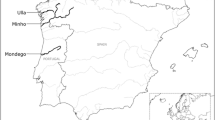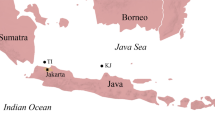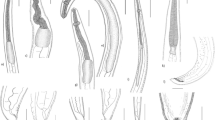Abstract
Two gadiform species with a successive bathymetric and an ecological and economical importance in the Mediterranean fishing industry, Phycis blennoides and Phycis phycis, were selected for the present study. A total of 592 fresh specimens belonging to the Gadiformes genus were obtained from local commercial fisheries. The investigation was centred on anisakid parasites of 272 specimens of the greater forkbeard (P. blennoides) and 320 of the forkbeard (P. phycis) captured off the Mediterranean coasts of Tunisia (eastern Mediterranean Sea). Four species of nematodes were identified: Anisakis simplex s.1., Anisakis physeteris, Hysterothylacium aduncum and Hysterothylacium fabri. The total prevalence was 53.75% in the forkbeard and 51.47% in the greater forkbeard. The highest values of prevalence (38.75%, 2–14), mean intensity (6.74±3.4) and mean abundance (2.61) were all obtained for H. fabri L4 in the forkbeard. The most frequent parasite in the greater forkbeard was H. aduncum L3 with 32.35% (1–3) prevalence and values of 1.21±0.58 and 0.39 for mean intensity and mean abundance, respectively. The infestation parameters were also analysed according to the host length, and prevalence was highest in P. blennoides longer than 35 cm in respect of all anisakid species. Whilst in P. phycis, the highest prevalence, conditioned by H. fabri parasitisation, was found in fish with length reaching a maximum of more than 40 cm. When the data were grouped seasonally, clear patterns were observed for P. blennoides and P. phycis species, with prevalence and mean intensity of all the anisakid species peaking in spring and summer.




Similar content being viewed by others
References
Beverly-Burton M, Nyman OL, Pippy JHC (1977) The morphology and some observations on the population genetics of Anisakis simplex larvae (Nematoda: Ascaridata) from fishes of the North Atlantic. J Fish Res Board Can 34:105–112
Bush AO, Lafferty KD, Lotz JM, Shostak AW (1997) Parasitology meets ecology in its own terms: Margolis et al revisited. J Parasitol 83:575–583
Casas JM, Pineiro C (2000) Growth and age estimation of greater fork-beard (Phycis blennoides Brunnich, 1768) in the north and northwest of the Iberian Peninsula (ICES Division VIIIc and IXa). Fish Res 47:19–25
Cohen DM, Inada T, Iwamoto T, Scialabba N (1990) FAO species catalogue. Vol. 10. Gadiform fishes of the world (Order Gadiformes). An annotated and illustrated catalogue of cods, hakes, grenadiers and other gadiform fishes known to date. FAO Fish Synop 10:1–442
Doupé RG, Lymbery AJ, Wong S, Hobbs RP (2003) Larval anisakid infections of some tropical fish species from north-west Australia. J Helminthol 77:363–365
Lloret J, Lleonart J (2002) Recruitment dynamics of eight species in the northwestern Mediterranean sea. Sci Mar 66(1):77–82
Lymbery AJ, Doupe RG, Munshi MA, Wong T (2002) Larvae of Contracaecum sp. among inshore fish species of southwestern Australia. Dis Aquat Org 51(2):157–159
Macpherson E (1978) Régimen alimentario de Phycis blennoides (Brunich) y Antonogadus megalokynodon (Kolombatovic) (Pisces: Gadidae) en el Mediterraneo occidental. Investig Pesq 42:455–466
Margolis L, Esch GW, Homes JC, Kuris AM, Shad GA (1982) The use of ecological terms in parasitology (Report of an and hoc committee of the American Society of Parasitologists). J Parasitol 68:131–133
Moravec F (1994) Parasitic nematodes of freshwater fishes of Europe. Kluwer, Dordrecht, p 473
Moravec F, Nagasawa K, Urawa S (1985) Some fish nematodes from freshwaters in Hokkaido Japan. Folia Parasitol 32:305–316
Moravec F, Vivas-Rodriguez C, Scholz T, Mendonza-Franco E, Schmitter-Soto JJ, González-Solís D (1995) Nematodes parasitic in fishes of cenotes (=sinkholes) of the Peninsula of Yucatán Part 2 Larvae. Folia Parasitol 42:199–210
Moravec F, Prouza A, Royero R (1997) Some nematodes of freshwater fishes in Venezuela. Folia Parasitol 44:33–47
Papaconstantinou C, Caragitsou E (1989) Feeding interaction between two sympatric species Pagrus pagrus and Phycis phycis around Kastellorizo Island (Dodecanese, Greece). Fish Res 7(4):329–342
Petter AJ, Maillard C (1988) Larves d’Ascarides parasites de poissons en Méditerranée occidentale. Bull Mus Hist Nat Paris 4(10):347–369
Petter AJ, Radujkovié BM (1989) Parasites de poissons marins du Monténégro: Nématodes. Acta Adriat 30(1–2):195–236
Petter AJ, Lebre C, Radujkovié BM (1984) Nématodes parasites de poissons ostéichtyens de l’Adriatique méridionale. Acta Adriat 25:205–221
Poulin R, Rohde K (1997) Comparing the richness of metazoan ectoparasite communities of marine fishes: controlling for host phylogeny. Oecologia 110:278–283
Rokicki J, Valter ED, Myjak P (1993) Contracaecum osculatum (Nematoda, Anisakidae) in cod Gadus morhua L. from the Polish coast of the Baltic. Acta Parasitol 38(1):33–35
Rosales MJ, Mascaro C, Fernandez C, Luque F, Moreno MS, Parras L, Cosano A, Munoz JR (1999) Acute intestinal anisakiasis in Spain: a fourth-stage Anisakis simplex larva. Mem Inst Oswaldo Cruz 94(6):823–826
Rotllant G, Moranta J, Massuti E, Sarda F, Morales-Nin B (2002) Reproductive biology of three gadiform fish species through the Mediterranean deep sea range. Sci Mar 66(2):157–166
Shiraki T (1974) Larval nematodes of family Anisakidae (Nematoda) in the northern Sea of Japan as a causative agent of eosinophilic phlegmone or granuloma in the human gastro-intestinal tract. Acta Med Biol 22:57–98
Timi T, Sardella NH, Navone GT (2001) Parasitic nematodes of Engraulis anchoita Hubbs et Marini, 1935 (Pisces, Engraulidae) of the Argentine and Uruguayan coasts South West Atlantic. Acta Parasitol 46(3):186–193
Valero A, Paniagua MI, Hierro I, Diaz V, Valderrama MJ, Benitez R, Adroher FJ (2005) Anisakid parasites of two forkbeards (Phycis blennoides and Phycis phycis) from the Mediterranean coasts of Andalucia (Southern Spain). Parasitol Int 55(5):1–5
Wharton DA, Hassal ML, Aalders O (1999) Anisakis (Nematoda) in some New Zealand inshore fish. NZ J Mar Freshw Res 33:643–648
Acknowledgement
The authors are grateful to Dr. Paolo Merrella (University Degli Studi di Sassari) for his help in sample analyses and his assistance in the preparation of the manuscript.
Author information
Authors and Affiliations
Corresponding author
Rights and permissions
About this article
Cite this article
Farjallah, S., Slimane, B.B., Blel, H. et al. Anisakid parasites of two forkbeards (Phycis blennoides and Phycis phycis) from the eastern Mediterranean coasts in Tunisia. Parasitol Res 100, 11–17 (2006). https://doi.org/10.1007/s00436-006-0227-7
Received:
Accepted:
Published:
Issue Date:
DOI: https://doi.org/10.1007/s00436-006-0227-7




